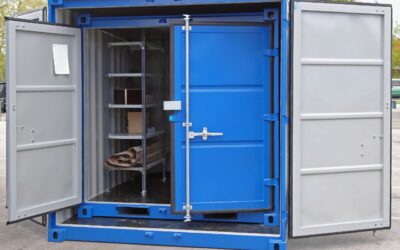If you need to transport or store large quantities of perishable goods or merchandise/stock that are vulnerable to extreme changes in temperature, then chances are you’ll be looking at a Reefer or Insulated Shipping Container.
Although they are very similar types of containers, they do perform and are used in slightly different ways.
To help you make the right choice, we thought we’d answer some of the most frequently asked questions we get about these containers so you can make an informed decision that best suits your needs
Reefer Containers – FAQs
What does a Reefer Container actually mean?
A “Reefer” Container is the industry-used nickname for a Refrigerated Container. In essence, they are heavy-duty shipping containers with their own installed refrigeration units. They work by circulating (usually) chilled air throughout the container allowing owners to set and maintain internal temperatures. This makes Reefer Containers excellent shipping container solutions for the transport of frozen and perishable goods. Widely seen in cargo ships around the world, there are literally millions of Reefer Containers in use today.
What is the main difference between a Reefer and a standard container?
Besides the obvious existence of a refrigeration unit, there are a few other differences between Reefer Containers and standard shipping containers. While standard shipping containers are constructed with quite a comparatively thin layer of steel, Reefer Containers are heavily insulated with a two-layered vacuumed wall that prevents heat from being transferred outside the container. The flooring is typically also different, with most Reefer Containers featuring a T-aluminium floor. This creates a space underneath the cargo which allows air to be more effectively circulated within.
Is the Reefer Container insulated?
As just discussed, all Reefer Containers come fully insulated, a fact being a key requirement of their functionality. They are also, by default, vermin, wind and watertight, again vital for maintaining the internal temperature within. Ventilation also prevents the build-up of condensation and moisture which can be extremely damaging to products and produce, regularly transported in this way.
How do you use a Reefer Container?
When using a Reefer Container there are a number of things you should be mindful of. Firstly, overloading is something to be avoided, staying below the red load line within the container. This will ensure that air is able to be properly circulated within the container, key to maintaining a consistent temperature. Cargo should also not extend beyond the T-aluminium floor for the same reason. Goods, like some fruit, may also require pre-cooling before loading to prevent microbiological growth. For obvious reasons, you should also ensure that your goods are stable and secure when loaded to prevent breakages during travel.
How cold does a Reefer get?
The temperature range of Reefer Containers can vary between manufacturer and model so it’s always important to check that the container you’re getting, meets your requirements. Reefer Containers supplied by OZBOX typically have a temperature-controlled range of -40°C up to +35°C, suitable for most applications requiring this type of container. Feel free to check with our team for any specific queries on this.
What are Reefer Containers used for?
While the transport of produce and perishables is the main purpose for Reefer Containers, they are also frequently used as additional storage units of the same goods. Supermarkets and convenience stores are common clients with respect to this, requiring additional chilled storage at busy times of the year. Popular restaurants, hotels and other establishments also often use Reefer Containers in this way during peak season, when onsite refrigeration storage does not suffice. Outside hospitality, the pharmaceutical industry is also a frequent user of Reefers for the transport/storage of drugs that need to be kept at specific temperatures.
Insulated Containers – FAQs
What is the main difference between an Insulated Container and a Reefer Container?
As we mentioned at the top, there’s very little difference between a Reefer Container and an Insulated Container. That’s because an Insulated Container is essentially a Reefer Container without a refrigeration unit. In the industry, it is often known as a non-operational refrigerated container. Though the difference seems small, it does significantly change what it’s used for with some strong reasons and advantages for doing so.
Why are Insulated Containers important?
Insulated Containers are important because they exist in the middle ground between Reefer Containers and standard dry containers. They are used for the great many products that don’t require a specific set temperature (chilled or otherwise) but do require a maintained ambient temperature. Insulated Containers serve this exact purpose and are also wind, water and vermin proof ensuring greater protection for stock and goods. Their heavy-duty construction is also able to withstand extreme external temperatures ranging from -40°C to +70°C.
What are Insulated Containers used for?
Insulated Containers are widely used for the transport of some food, beverages, pharmaceuticals, clothes, furniture, electronics and more. Much like Reefers, they are also used for temporary storage too including those looking to store personal possessions which aren’t as commonly seen with Reefer Containers. In addition to this, they are also popular products to use for container modification, making comfortable living and/or office spaces. We’ve even seen people modify insulated containers into wine cellars, opening the door to those with a sizeable wine collection.
Why would I choose an Insulated Container over a Reefer?
If you have goods that only require a stable ambient temperature for transport and/or storage then we would ordinarily recommend an Insulated Container. While a Reefer Container can arguably perform the same function, you would effectively be choosing (and paying for) a product whose main features you don’t need. Reefers also require a power source, making an Insulated Container a more cost-effective solution, especially over a long period of time. With no electrical components to control or upkeep, it is also a more user-friendly alternative that requires little to no maintenance.
What sizes do Insulated Containers come in?
Insulated Containers are available as both 20ft and 40ft containers giving you great flexibility to meet your needs. If you are dealing in bulk goods, you’ll generally find it more cost-effective to get a single 40ft over two 20ft containers. If you have space limitations (for storage) you might find managing two 20ft containers a little easier.
Your Reefer And Insulated Container Questions, Answered!
As you can see both Reefer and Insulated Shipping Containers have a wide variety of uses for an equally wide range of products. We hope that the distinction between the two container types is clearer than it was before and you’re able to make the choice that is right for you. If you find you have any further questions about these containers or anything related to our shipping container services, don’t hesitate to get in touch with our customer-focussed team at OZBOX!









